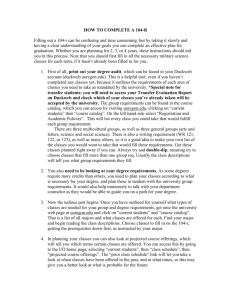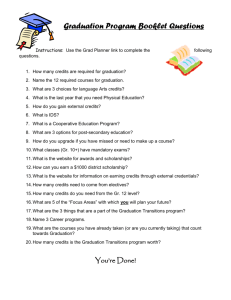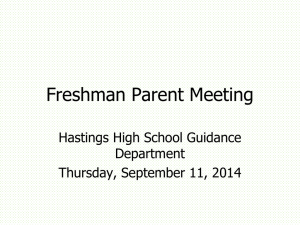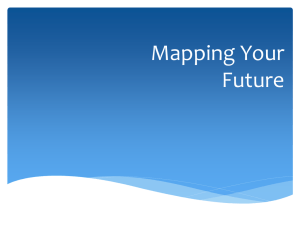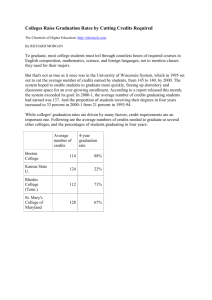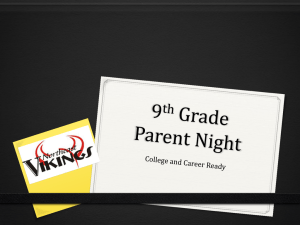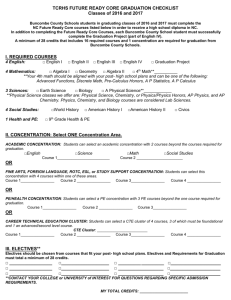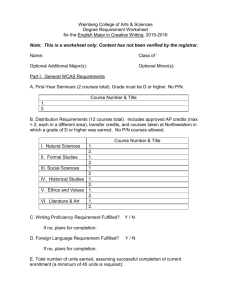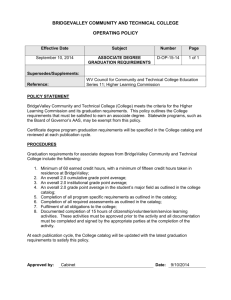Word
advertisement
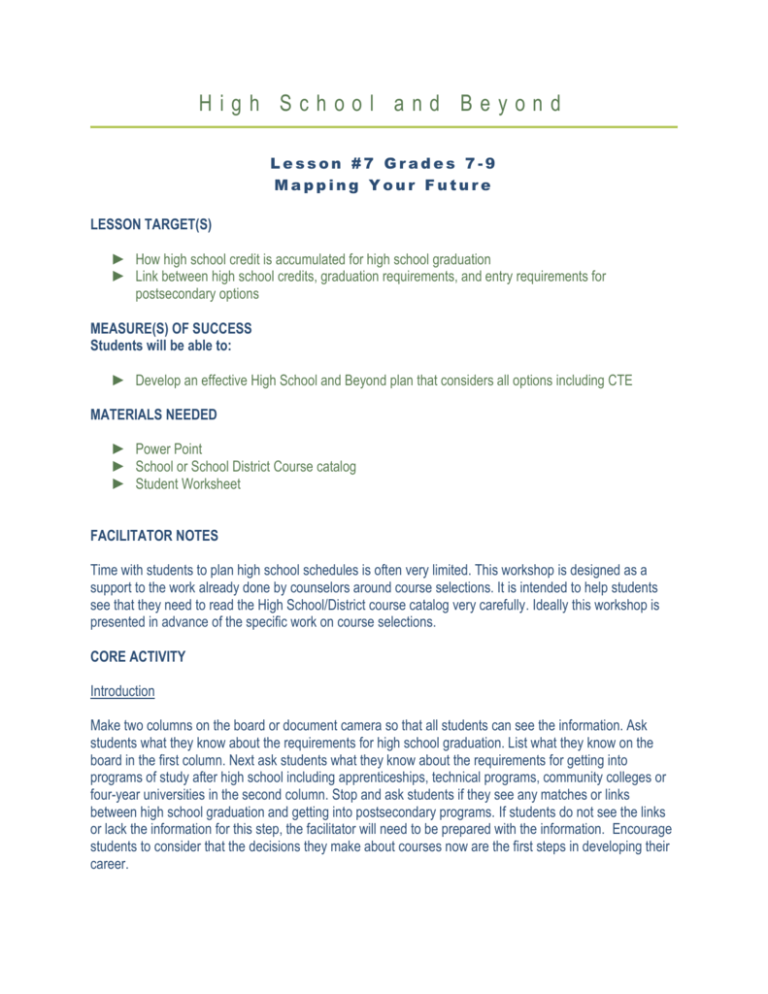
High School and Beyond Lesson #7 Grades 7-9 Mapping Your Future LESSON TARGET(S) ► How high school credit is accumulated for high school graduation ► Link between high school credits, graduation requirements, and entry requirements for postsecondary options MEASURE(S) OF SUCCESS Students will be able to: ► Develop an effective High School and Beyond plan that considers all options including CTE MATERIALS NEEDED ► Power Point ► School or School District Course catalog ► Student Worksheet FACILITATOR NOTES Time with students to plan high school schedules is often very limited. This workshop is designed as a support to the work already done by counselors around course selections. It is intended to help students see that they need to read the High School/District course catalog very carefully. Ideally this workshop is presented in advance of the specific work on course selections. CORE ACTIVITY Introduction Make two columns on the board or document camera so that all students can see the information. Ask students what they know about the requirements for high school graduation. List what they know on the board in the first column. Next ask students what they know about the requirements for getting into programs of study after high school including apprenticeships, technical programs, community colleges or four-year universities in the second column. Stop and ask students if they see any matches or links between high school graduation and getting into postsecondary programs. If students do not see the links or lack the information for this step, the facilitator will need to be prepared with the information. Encourage students to consider that the decisions they make about courses now are the first steps in developing their career. You will need to adjust pace of the PowerPoint depending on the background knowledge students have around high school courses. Be prepared to stop and answer questions or add information as needed if this is new to most students. Activity 1. Slide 1, Opening Slide: Share with students that this workshop focuses on learning more about what courses to choose to set them on the path to the careers that interest them most. 2. Slide 2, Mapping Your Future: Ask students if they have already heard the myth that you need to take easy courses in high school or the fewest courses possible. Challenge the students to think why this might not be the best strategy. Encourage them to think about setting the bar high! 3. Slide 3, Credits: Ask students to turn to a neighbor and share ways that people are recognized for their achievements. Some examples would be MVP awards in sports or recognition of batting averages or judges opinions and public votes on TV talent shows. Share with students that the recognition a student has successfully completed a course is an award of a course “credit”. Make sure students know this is different than a “grade”. A grade shows how well you have completed the course. If you receive an F, it shows that you have NOT completed the course at a satisfactory level. 4. Slide 4, Credits: Share with students that one semester of work equals one-half of a credit. Before turning to the next slide, have students guess how many credits the State of Washington suggests for graduation. 5. Slide 5, Required High School Credits: It is important to know that while the State of Washington requires 20 credits for graduation, the state also highly recommends that students take at least 24 credits to be career and college ready. Point out that high schools do vary in how many credits are required. 6. Slide 6, Let’s Do the Math: When students look at the list of courses the number required that may seem like a lot. Use this slide to have students personalize the number of classes they will be taking each semester. Compare this to the number of classes they are taking in middle school now. 7. Slide 7, Two Kinds of Credit-bearing Courses: Explain to students that there are areas of study and specific classes that will be required for graduation and those that the students may choose. Give examples of courses from your course catalog of the required courses and electives. 8. The next slides are “text-dense” in order to give students across the state consistent definitions. Share with students that there are four different ways that they can specifically begin to work on their careers and prepare for college while they are still high school students. A good way to open this section before showing the slides is to have students think about what they bought in the grocery store that was a 2:1 offer. Slide 8, Career and College Options o Two-for-One 2016: Share with students that all high schools in Washington State require students to complete occupational courses. There will be courses in their high schools that allow students to complete an academic requirement and a career/technical or occupational requirement at the same time. Encourage students to discuss how this can open up their schedule for a greater diversity of courses and/or a deeper concentration in an area they want to study. o College Tech Prep: Explain to students that College Tech Prep (there is an entire workshop on this available) helps students to accelerate their college career and begin to work on a specific area of study while they are still in high school. These Tech Prep courses offer “dual-credit” or both high school and college credit if a student earns a “B” grade or higher in the course. Share with students that the average of a 5 credit course at the local community or technical college is $350.00 plus books, lab fees and parking. This same course in a Tech Prep, Dual-Credit program will cost students a one-time only $25 per college application fee. Give examples: Accounting Culinary arts Auto Tech Construction Computer Software Fisheries Technology 9. Slide 9, Career and College Credit Options o Advanced Placement Courses: Be sure to know the school’s or school district’s policy on who can take Advanced Placement courses. It will important for students to know the admissions requirements for these courses early. Share with students that Advanced Placement courses require extra work, often extensive reading and homework, in order to pass the course. College credit is awarded after students take a national test. o Running Start: Again, be sure to know what is available to the students in your area. Share with students that upper level students, juniors and seniors, often elect to take courses at area technical or community colleges to get a “running start” at their college degrees. Make sure that students know that while the tuition is paid by the state, students will be treated like college students and will need to complete the work at a satisfactory level in order to receive high school and college credit. 10. Stop at this point and go back to the three lists from the opening of the workshop/lesson. Ask students to add additional information and/or additional questions. The previous steps are very information and text dense so allow enough time for students to ask questions and discuss what they are learning. 11. As time allows in this workshop or even in a second workshop, now allow students a hands-on exploration of the course catalog. Use the student worksheet and Slide 10 from the Power Point to help students become much more familiar with what their high school offers. One way to do this is to divide students in small groups that will each “research” one of the areas in the course catalog and report out what they’ve learned to the class. These areas would be: o o o o English Math Science Social Studies o o o o o o Arts World Language Health and fitness Occupational Education Career Concentration Electives 12. Allow adequate time for each group to share what they have learned from their “research”. Closing Ask students to share what they’ve learned that will now influence their selection of courses in high school. What do they see as the challenges and the opportunities of selecting courses? Student Worksheet: Mapping Your Future Area of Research/Course of Study (Circle one) English Math World Language Questions How many credits are needed in this area for graduation? Is the number of credits for graduation different than if you want to go to a four-year college? What variety of course opportunities are available? What courses might be most helpful if you are looking at a career/technical program? What courses are offered that would allow you to acquire college credit? What did you notice about this area that every student should know? Science Social Studies Health and Fitness Arts Occupational Education Notes and Answers

